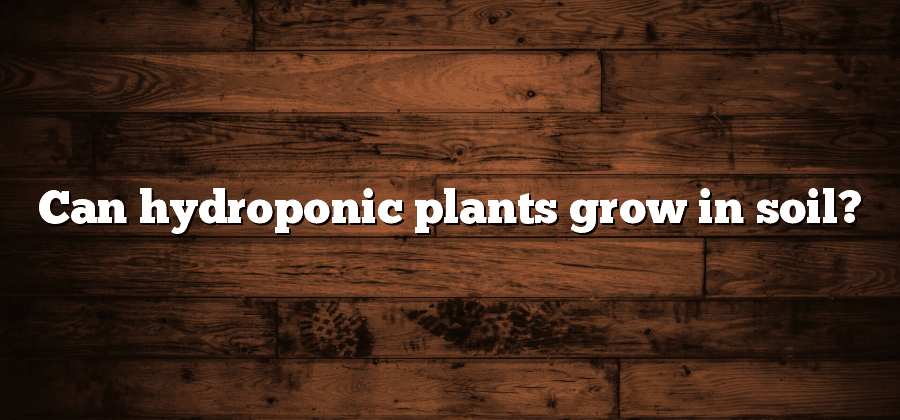Hydroponic Plants vs Soil-based Plants
Hydroponic plants and soil-based plants are two distinct methods of growing plants that have their own set of advantages and disadvantages.
Hydroponic plants are cultivated without the use of soil, relying instead on a nutrient-rich water solution. This method allows for precise control over the plant’s growing conditions, such as pH levels and nutrient intake. The absence of soil also eliminates the risk of soil-borne diseases and pests, promoting healthier plant growth. Additionally, hydroponic systems require less space and can be set up in both indoor and outdoor environments.
On the other hand, soil-based plants are grown in traditional soil, which provides a natural environment for roots to anchor and access nutrients. Soil acts as a buffer, helping to regulate water availability and preventing plant stress. Furthermore, soil contains beneficial microorganisms that aid in nutrient absorption and enhance plant growth. Soil-based plant cultivation is also typically less expensive to set up and maintain compared to hydroponic systems.
In summary, the choice between hydroponic plants and soil-based plants ultimately depends on various factors such as available resources, desired plant characteristics, and cultivation goals. Both methods have their own merits and can be successfully employed to grow a wide range of plants, providing ample options for horticultural enthusiasts and commercial growers alike.
Hydroponic Systems Explained
Hydroponic systems provide an innovative approach to cultivating plants without the use of soil. These systems rely on a nutrient-rich water solution to deliver essential elements directly to the roots. By doing so, hydroponics ensures optimal nutrient absorption, promoting healthier and faster plant growth.
One of the key components of a hydroponic system is the growing medium. Unlike traditional soil-based gardening, hydroponics utilizes materials such as perlite, vermiculite, clay pellets, or rockwool. These mediums provide stability to the plants while allowing the roots to access the nutrient solution easily. Additionally, hydroponic systems can be designed to be highly automated, controlling factors such as pH levels, temperature, and lighting to create the ideal growing conditions.
Advantages of Hydroponic Plant Growth
As an innovative agricultural technique, hydroponic plant growth offers several advantages over traditional soil-based methods. Firstly, hydroponic systems allow for precise control of nutrient levels, ensuring that plants receive the ideal amount for optimal growth. This eliminates the guesswork of soil fertilization and enables plants to receive a perfectly balanced diet. Additionally, hydroponic plants are not affected by soil-borne diseases or pests, as they are grown in a sterile environment. This reduces the need for harmful pesticides or fungicides, making hydroponic plants a safer and more environmentally friendly option.
Furthermore, hydroponic systems require significantly less water compared to soil-based cultivation. This is due to the recyclable nature of the nutrient-rich water solutions used in hydroponics. As water is continuously circulated and reused in closed-loop systems, there is minimal waste and evaporation. In regions where water scarcity is a concern, hydroponic plant growth offers a sustainable solution that conserves this precious resource. Moreover, the controlled environment of hydroponics allows for year-round cultivation, making it possible to grow crops regardless of seasonal limitations.
It is clear that hydroponic plant growth offers numerous advantages that contribute to its increasing popularity among farmers and horticultural enthusiasts. From precise nutrient control to reduced water consumption, this innovative method provides an efficient and sustainable approach to indoor farming.
Disadvantages of Hydroponic Plant Growth
Hydroponic plant growth, although promising in many aspects, also comes with its fair share of drawbacks. One significant disadvantage is the high setup and maintenance costs associated with hydroponic systems. Compared to traditional soil-based methods, hydroponics requires specialized equipment such as grow lights, pumps, and nutrient solutions, which can quickly add up and strain the financial resources of small-scale growers or enthusiasts.
Another challenge faced by hydroponic plant growth is the dependency on technology and electricity. Since hydroponics relies on artificial lighting and controlled environments, any disruption in power supply or equipment malfunction can have severe consequences on the plants’ growth. This reliance on technology not only increases the overall expenses but also adds an element of uncertainty, making it crucial for growers to have backup power sources and regular maintenance checks to mitigate any risks. Additionally, the need for continuous monitoring and fine-tuning of environmental factors further adds to the complexity and time requirements of managing hydroponic systems.
The Role of Nutrients in Hydroponic Systems
Hydroponic systems have gained popularity in recent years due to their efficient and controlled method of plant growth. One key element that plays a crucial role in these systems is the use of nutrients. Unlike traditional soil-based plants that derive nutrients from the soil, hydroponic plants rely on a nutrient solution to support their growth and development.
The nutrient solution used in hydroponic systems consists of a carefully balanced mixture of essential elements needed for plant growth, such as nitrogen, phosphorus, and potassium. These nutrients are dissolved in water and delivered directly to the plant roots, ensuring that they have easy access to the necessary nourishment. By providing a precisely measured amount of nutrients, hydroponic systems allow plants to receive an optimal balance of nutrition, resulting in faster growth rates and higher yields.






